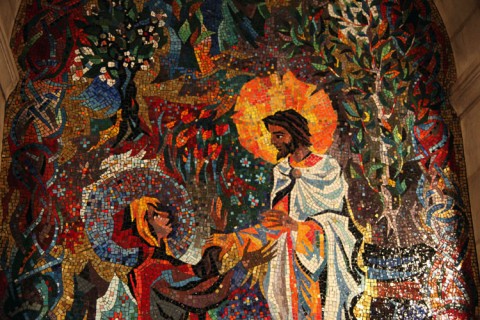Easter Sunday, April 8, 2012: John 20:1–18
The risen Christ does not rebuke Mary for her error. He seems rather to enjoy the occasion of her surprise.

John's telling of the encounter of Mary Magdalene with the risen Christ is striking for its narrative perspective. This might seem to be among its less remarkable features to most readers, but a writer reads a story differently than other people do, noticing technique and workmanship the way any artisan will consider a product of her craft—the mystery of it, as they said in the Middle Ages. And the way in which a story is told, its angle of vision, has everything to do with what it means, and is therefore a matter of great interest to anyone who is attentive to the art of narrative.
The accounts of the resurrection famously differ from one Gospel to the next, and this fact enhances the interest of an element they share, the skepticism of the earliest witnesses. Mary Magdalene, when she finds the tomb empty, simply assumes someone has carried the body away, perhaps the gardener she does not recognize as Jesus. Others of his followers do not recognize him when he is among them, in large part because they believe he is, in the way of mortals, dead and gone. In every case the angle of vision is a skepticism based on the expectation that with Jesus' death things will have taken their ordinary course. In other words, this-worldliness is foregrounded, even while the events themselves are nothing less than the grandest of theophanies.
Read our latest issue or browse back issues.
Peter and the other disciples run to see the empty tomb when they are told of it, but apparently draw no conclusions—"Then the disciples went back to their homes." Even after Mary has spoken with angels, she explains the body's absence to herself in just the way any rationalist might do, not even pausing to wonder. And Thomas is the ultimate empiricist in his insistence that he must touch Christ's wounds. It is clear from the metaphysics of the prologue that John's Christ might have appeared to his followers as an effulgence of holy light. Instead, as he does appear to them, he might be any man tending a fire at the shore, any stranger urged to share supper. The realism of the expectations of each of his witnesses establishes for the reader the way in which Jesus was known to them, as a much revered, much beloved and very mortal man, the last an impression the crucifixion would seem to have confirmed.
This true humanity in turn establishes the full meaning of his incarnation, over against the tendency of variant traditions to make his presence on earth wholly spiritual, his incarnation only apparent. The Gospel of John is emphatic on two points—that the God of Christ made the world and that he loves it. These assertions and all that follows from them run counter to the dualisms that would rescue Christ from compromising association with a vile and corrupt creation. The perspective of the Gospel witnesses, the choices that are made in the telling of their experience, achieve a profound theological statement. Like God himself, the Gospel writers are loyal to this world. The unique burden of the Gospels is "that the Word became flesh and dwelt among us," one human being among others. The realism of the events they describe is essential to the meaning of their witness.
The New Testament genealogies set events within the saga of the people Israel. The episodes of encounter with ordinary soldiers, fishermen and tax gatherers, the sort of people who crowded the streets of daily life through most of the history of civilization, establish the human character of Jesus. Frictions between imperial and temple authority in Jerusalem place the narrative in a very specific moment in time. Gnostic writings, by comparison, are collections of sayings, with only a hint here and there of interaction among characters who are, with the exception of a sage called Jesus, no more than names. A modern reader might take the story of Jesus' life to be implicit in these texts. But a radically different cosmology lies behind the Gnostic scriptures, one that scorns the world together with the demiurge who made it. Freed of the difficult love for human-centered reality that pervades the whole of the Bible, these scriptures abandon the conception of God, the monotheism, of the Abrahamic traditions.
An artful anticipation of disbelief is so characteristic of all the Gospels that the reason for it is worth considering. The much-noted tendency of the disciples to miss the point, the emphasis the telling gives to their failures of comprehension, might be described as a narrative strategy for maintaining and honoring a human perspective, for making simultaneous a sense of the utterly human and the wholly divine. The risen Christ does not rebuke Mary for her error. He seems rather to enjoy the occasion of her surprise. Neither does he reject his disciples, for all their failings. The holy in all its otherness is addressed to and profoundly loyal to this world. That the two realities, earthly and divine, are simultaneous rather than opposed is a central assertion of the Bible from the creation to the resurrection. And the foregrounding of mundane and mortal experience, in light of the grace that comprehends it, maintains this most difficult synthesis. This strategy is a triumph of art. One might call it inspired.
©2012 Marilynne Robinson






